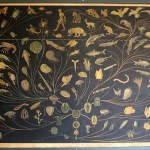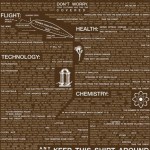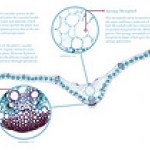Science
Physics World has a nice news article about a new experimental development in quantum computing, based on a forthcoming paper from the Wineland group at NIST in Boulder. I'd write this up for ResearchBlogging, but it's still just on the arxiv, and I don't think they've started accepting arxiv papers yet.
The Physics World piece summarizes the key results nicely:
Now, Brad Blakestad and colleagues at the National Institute of Standards and Technology (NIST) in Boulder, Colorado have created a junction in an ion trap in which there is practically no heating. Constructed from laser-machined…
My first column is up on the Guardian web site: it's a brief introduction to asymmetries in snails, an abbreviated version of the post that I fleshed out with a little more detail.
I have to complain a little, though: the title says the observation of shared molecules between molluscs and humans "proves" we're related. I really don't like the use of the word "proof", because it doesn't — it is compatible with the hypothesis, or it supports the idea, but biologists don't dabble in proofs.
There's also an error on my part: I somehow transposed the stomach and liver. I know where these organs…
I've been busy — I'm teaching genetics this term, and usually the first two thirds of the course is trivial to prepare for — we're covering Mendelian genetics, and the early stuff is material the students have seen before and are at least generally familiar with the concepts, and all I have to do is cover them a little deeper and with a stronger quantitative component. That's relatively easy.
The last part of the course, though, is where we start moving into uncharted waters for them, and every year I have to rethink how I'm going to cover the non-Mendelian concepts, and sometimes my ideas…
Over 9 months ago I decided to apply for teaching tenure track jobs. Then the economy took what can best be described as a massive, ill-aimed, swan dive. Thus creating an incredible amount of stress in my life. So what does a CS/physics research professor do when he's stress? The answer to that question is available on the iTunes app store today: arXiview. What better way to take out stress and at the same time learn objective C and write an iPhone app that at least one person (yourself) will use?
What is arXiview? It is yet another arXiv viewer (there are two others available, last I…
Messor capensis nests, as seen by The Google
Over at Photo Synthesis, commentator Kate directs our attention to Messor capensis, a South African seed harvester whose nests from the air look like some form of fungal growth. Except much, much bigger. (coordinates here: 33° 36â57.32âS, 22° 08â06.38âE)
I've only got one really crappy photo of the beast, but I'll subject you to it anyway:
More Google Earth ants here and here.
"You couldn't make this up: Cameras are being turned on the people paid to watch CCTV streams, to note which bits of surveillance footage they didn't see." via BoingBoing
The beauty of sand, close up -- a photo gallery at Discover.
Robots as recruitment to science. "If you stick a robot--I don't care if you're talking about grade school kids or high school students--if you put a robot in the middle of the room, there is something captivating about the technology." from Making Robots Personal - an interview with Tandy Trower of Microsoft Robotics. I find this particularly relevant as my 7-y.…
A recurring problem in academic science is trying to correctly identify a single author. For example, I was reviewing a grant that made reference to a group, but not a specific paper, and needed to sift through a few pages of search results in order to determine which of the people with that surname was the one I was looking for.
I'm somewhat fortunate in that the combination of my last name and first initial is not common. The Harvard/ Smithsonian Astrophysics Data System turns up all of my papers and nothing else when searching for "Orzel, C." The INSPEC database comes up with one bogus…
It is due in large part to Rettenmeyer's tireless tracking of army ants through all manner of tangled tropical jungle, for months on end, that we know as much as we do about those creatures. We've lost a real giant of myrmecology.
Over at Faraday's Cage, Cherish has had a Huck Finn moment with regard to paper writing style:
I know that I'm not supposed to use the first person plural when writing papers. Frankly Scarlet, I don't give a damn. I am going to say, "we did this" and "we did that".
This made me blink a little, because I've never thought that was a rule. In fact, one of the things I had beaten into my head when I was a grad student writing papers was that scientific papers ought to be written in the first person plural and the active voice.
There definitely seems to be a belief that scientific writing should…
As I put it at a blogging panel last fall, "in science, it is normative to be not sure." It wasn't my most eloquent moment, but at least AAAS' president-elect Alice Huang agrees with me that one of the biggest challenges to public science literacy is understanding the contingent nature of scientific "truth".
But probably the most difficult concept to get across to nonscientists is that we look at data and then use probabilities to judge those data. The public wants an absolute black-and-white answer. We may look at something that is 80 percent likely as being good enough to base decisions on…
In a post a few weeks ago, I included links to some current and recently passed legislation on food, food safety, and food labeling. One of them, H.R. 875 -- a bill "To establish the Food Safety Administration within the Department of Health and Human Services" -- has a particular devotion to "science" and "science-based" data and "science-based" practices. It's all so very post-Bush era. Debate about it is now starting to ramp up on-line.
But what got me thinking more about food and labeling was the Honest Tea Organic Honey Green Tea with 250 mg of EGCG Super Anti-oxidant I recently…
My first column in the Guardian science blog will be coming out soon, and it's about a recent discovery that I found very exciting…but that some people may find strange and uninteresting. It's all about the identification of nodal in snails.
Why should we care? Well, nodal is a rather important — it's a gene involved in the specification of left/right asymmetry in us chordates. You're internally asymmetric in some important ways, with, for instance, a heart that is larger on the left than on the right. This is essential for robust physiological function — you'd be dead if you were…
I've remarked several times that I think condensed matter physics gets slighted in public discussions of the field, especially relative to its usefulness. Particle physics gets all sorts of press, but in practical terms, it is essentially useless-- whether CERN or Fermilab locate the Higgs boson or not will make absolutely no difference in the lives of the average person. Condensed matter physics, on the other hand gets basically no press, despite the fact that modern technological civilization would be impossible without an understanding of condensed matter physics.
(I should note here that…
Kew Gardens (that is, the Royal Botanic Gardens at Kew) is trying to collect and bank the seeds and pollen from 10% of the world's plants -- a nice 21st-century continuation of the stunning collecting effort that started in the 1700s and helped supply evidence, via Joseph Dalton Hooker, that proved crucial to Darwin's theory of evolution through natural selection. The Guardian has put up a nice photo gallery of some of the seeds they've collected so far. A few:
Seed of wild spider flower (or spider wisp) Photo: Rob Kesseler & Madeline Harley
Himalayan iris pollen. Photo: Rob Kesseler…
Sponges are among the most primitive of all animals. They are immobile, and live by filtering detritus from the water. They have no brains or, for that matter, any neurons, organs or even tissues. If you were looking for the evolutionary origins of animal intelligence, you couldn't really pick a less likely subject to study.
So it was with great surprise that Onur Sakarya from the University of California, Santa Barbara found that sponges carry the beginnings of a nervous system.
With no neurons to speak of, these animals still have the genetic components of synapses, one of the most…
This beautiful painting is located in Martin Hall at Swarthmore College. Discovered via Colin Purrington's flickr feed.
Say you end up transported back in time, you can read English, and you're still on Earth: this T-shirt is your crib sheet for a successful career as visionary, inventor, and entrepreneur! Either that, or it will get you burned as a witch.
View larger here.
Wear/read/implement at your own risk. . .
Amyrmex: Dolichoderinae? Leptanilloidinae? Who knew?
A paper out this week in Zootaxa reminds us of the hazards of excessive reliance on the worker caste for ant taxonomy. Phil Ward and Seán Brady sequenced DNA from few genes from the enigmatic Amyrmex, a rarely-collected dolichoderine genus known only from males in South America. Except, it wasn't a dolichoderine. Surprise! Genetically, this little guy is part of the doryline section (the army ants and relatives) in the Leptanilloidinae.
Where did we go wrong with Amyrmex? In my opinion, it's in our…
Zea Poster from m f's flickr stream
Michael Franklin, Rochester Institute of Technology
One of the ways in which I can foresee Web 2.0 applications changing the culture of science is by increasing avenues for mentorship. Web apps allow students from different departments, universities, and nations to connect, collaborate, and exchange advice. This can mean career-changing help for students at small institutions (or for those at large institutions with poor interdepartmental relations or a dearth of experts in a particular field). I'm not just talking about help troubleshooting protocols; far…
My bedtime reading last night was an old pop-science book by Isaac Asimov, about black holes and astronomy generally. He talks at some length about the size and age of the universe, and just before I stopped and went to sleep last night, I reached his discussion of Cepheid variables, which begins thus:
In 1784 a Dutch English astronomer, John Goodricke (1749-1786)-- a deaf-mute who died at the age of 21-- noted that the star Delta Caphei (in the constellation Cepheus) varies in brightness.
After his death in 1770, Goodricke became a vampire, and continued his astronomical career for a…



